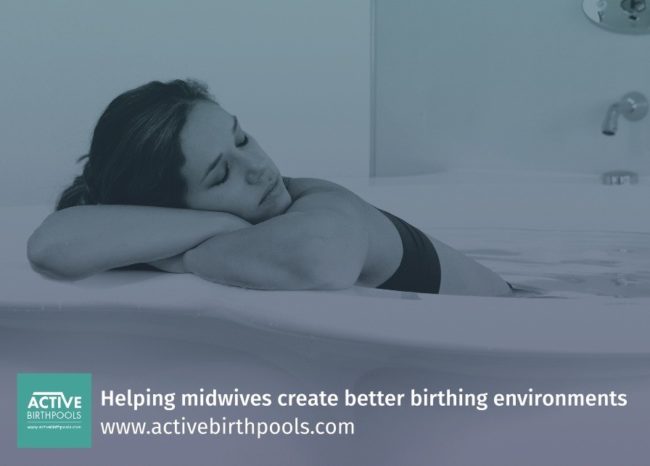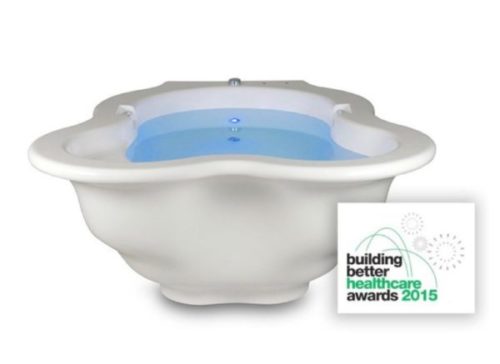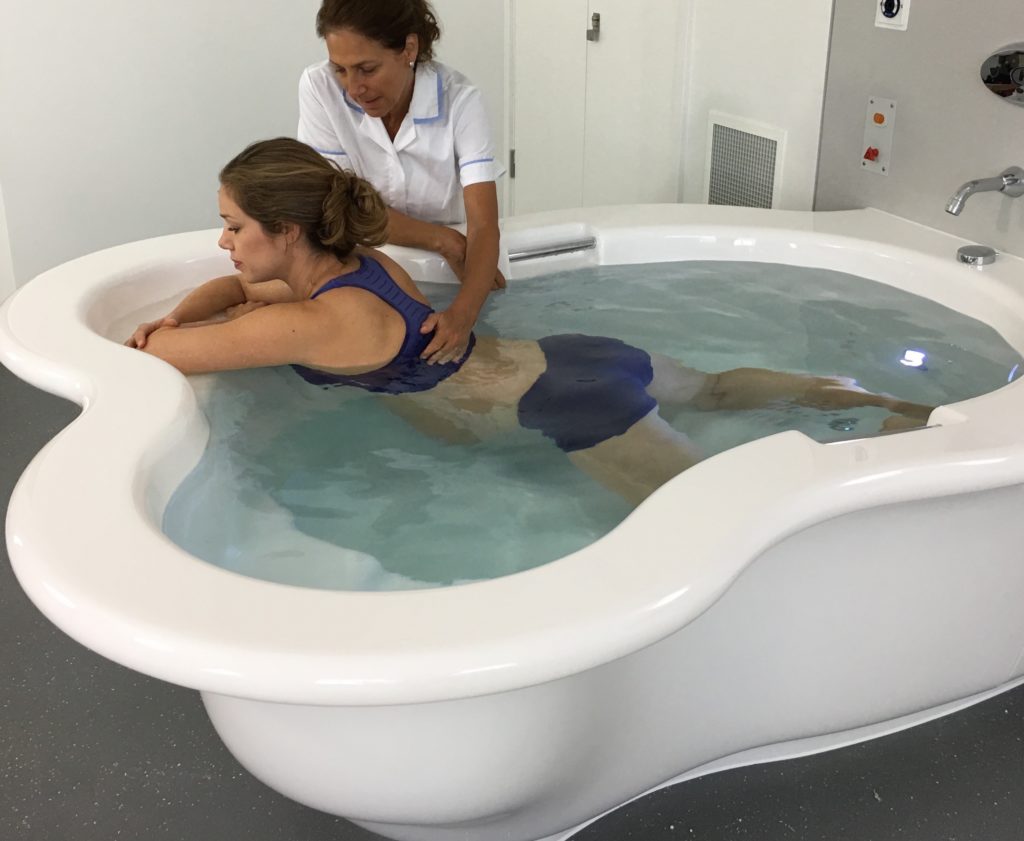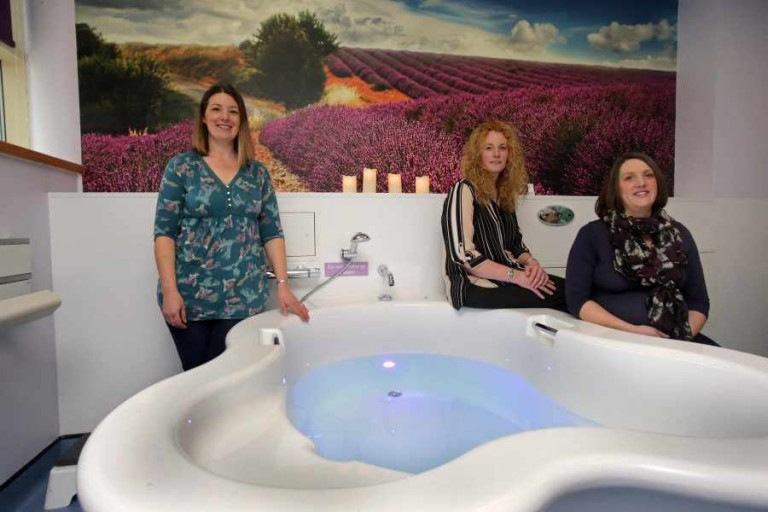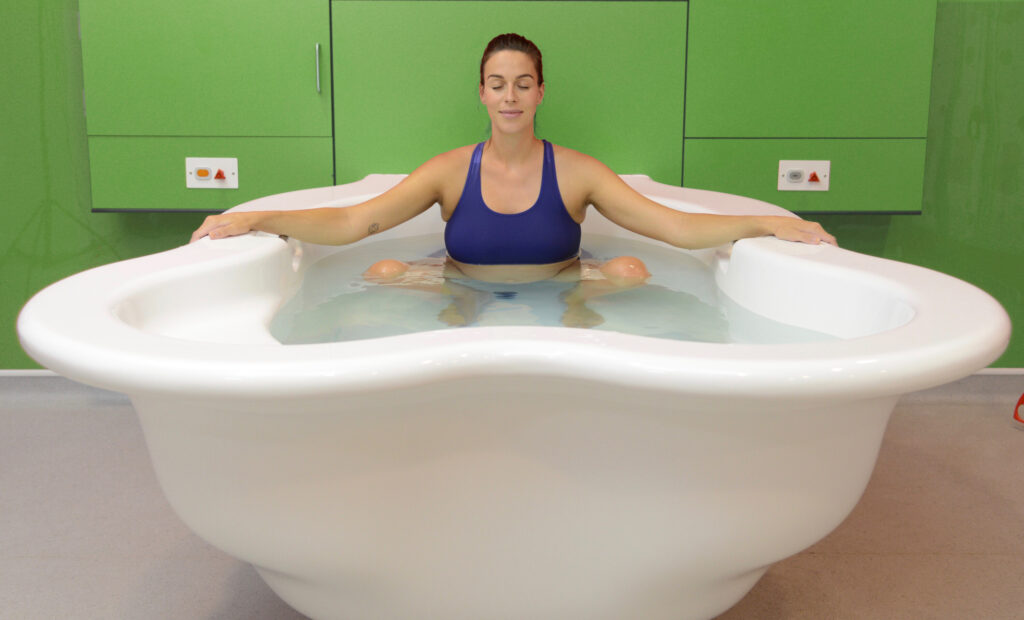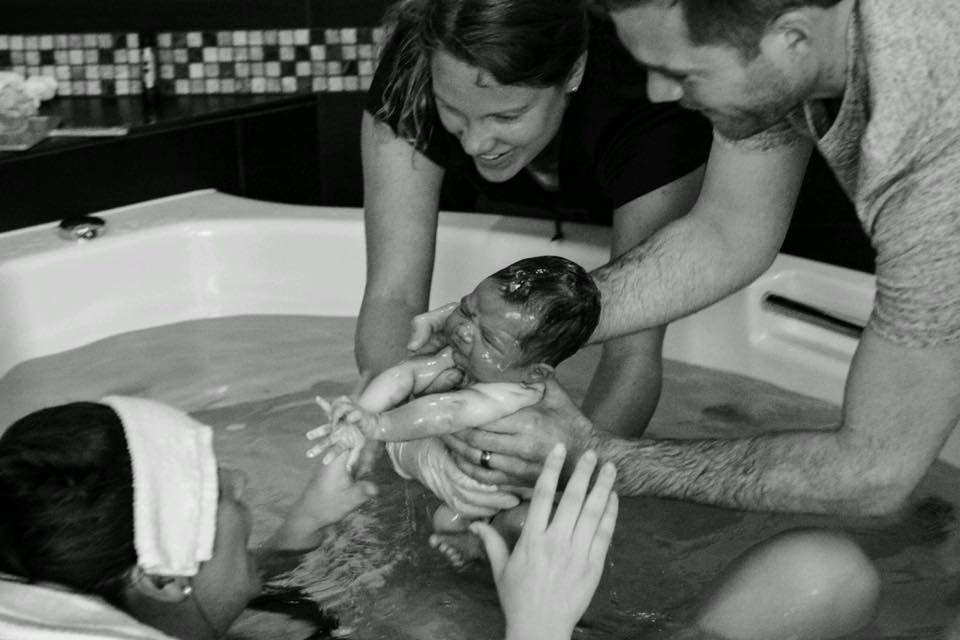8 December 2015:
Rowena Davies, RM, BA 1, 2
Deborah Davis RM, PhD1, 2
Melissa Pearce RM/RN, BNurs, GDipMid, GCertMid, MMidwifery2, 3
Nola Wong, RM/RN2, 3
1. Nursing and Midwifery, Faculty of Health, University of Canberra
2. The Australian Capital Regional Centre for Evidence Based Nursing and Midwifery Practice: an affiliate centre of the Joanna Briggs Institute
3. Centenary Hospital for Women and Children, Canberra
Corresponding author:
Rowena Davies
u3053358@uni.canberra.edu.au
The objective of this research is to systematically review the evidence regarding the effect of waterbirth, in comparison to land birth, on the mortality and morbidity of neonates born to low risk women.
Waterbirth and water immersion in labor are two distinct phenomena; however they are often confounded. Some women use water immersion in labor as a strategy to manage their labor pain but leave the bath prior to the birth of their baby.
As the name implies, however, waterbirth occurs when a baby is born underwater. This can happen either intentionally or accidentally, for example when a woman uses water immersion during labor and remains in the water to birth her baby.
Although the definitions of waterbirth and water immersion are simple to separate, descriptions of their use during a woman’s labor are often merged. 1,2
Given this, it is not surprising that research attempting to describe the benefits and risks of both water immersion and waterbirth is interwoven.
In many instances, discussion of waterbirth is confused by focusing on the benefits of water immersion for the woman and the risks of waterbirth to the neonate, two separate issues.
Water immersion in labor
Water immersion in labor has been used by many generations of women and is common practice in many birthing suites.3 Current research describes benefits for women using water immersion in labor including: increased relaxation4, pain relief5,6, maximized maternal satisfaction7, reduced length of labor2,3,5,8,9, reduced intervention3,10,11, increased spontaneous birth 12,13 and reduced first and second degree perineal tears.13,14
The buoyancy enabled by the water allows women to move easier during labor and potentially optimizes labor progress.3,6 Water immersion may also be associated with improved uterine perfusion, less painful contractions and a shorter labor.3,15,16
A Cochrane systematic review of eight trials comparing water immersion in labor with controls showed that water immersion resulted in a significant reduction in epidural analgesia use (478/1254 versus 529/1245; risk ratio [RR] 0.90; 95% [Confidence Interval [CI] 0.82 to 0.99, six trials]), a reduction in duration of the first stage of labor (mean difference -32.4 minutes; 95% CI -58.7 to -6.13, seven trials) with no difference in assisted vaginal birth (RR 0.86; 95% CI 0.71 to 1.05, seven trials), caesarean sections (RR 1.21; 95% CI 0.87 to 1.68, eight trials), use of oxytocin infusion (RR 0.64; 95%CI 0.32 to 1.28, five trials), perineal trauma (intact perineum, 236/678 versus 200/659, RR 1.16, 95% CI 0.99 to 1.35, five trials) or maternal infection (15/647 versus 15/648, RR 0.99, 95% CI 0.50 to 1.96, five trials). 5 There have been no studies that have identified any adverse effects of water immersion in labor for the woman or the neonate.
Waterbirth
The benefits to women of using water immersion in labor are evident. However, the practice of birth underwater remains controversial and the debate polarized, with research providing conflicting information and mixed results.
As a result of this confusion, many birthing units in Australia provide water immersion in labor as an option for women; however, implementing waterbirth policies remains a slow and complex process.17,18
The trend of waterbirth
The first recorded waterbirth occurred in France in 1803.19 After laboring for 48 hours, an exhausted woman used a warm bath and birthed a healthy baby.1 In the early 1980s, waterbirths became more popular as water immersion was promoted to help women relax and cope with their labor.20, 21
Currently, few women birth their baby underwater; however water immersion in labor is commonly available.20 Baths and birthing pools were integrated into the United Kingdom’s mainstream maternity units in 1992 after the House of Commons Health Committee recommended that all women have access to water for labor and birth.12
Their national practice guidelines also support the use of baths and birthing pools in labor.22 Within Australia, 14 of 19 birthing centres provide bath facilities.23 Further, waterbirth tends to be supported by midwives as it represents a birthing option congruent with midwifery philosophy.7,24
Concerns about waterbirth
In an uncomplicated pregnancy, water immersion is unlikely to harm the woman or her baby.5 Given this, many birthing units will restrict water immersion in labor to women with a low risk pregnancy.
Regarding waterbirth, commentators have developed a list of contraindications; however, due to a paucity of research in this area, this is based largely on opinion.18 Even so, the option to waterbirth remains restricted to women with a low risk pregnancy. Individual birthing units develop specific waterbirth protocols suiting their own circumstances and existing policy.
In a review of the evidence on waterbirth, Young and Kruske (2013) identified five main areas of concern: a perceived risk of neonatal water aspiration, neonatal and maternal infection, neonatal and maternal thermo-regulation, skills of attending midwives and emergency procedures in the event of maternal collapse. They concluded there was no evidence supporting these concerns.25
Although the practice of waterbirth has been linked to increased risk to the neonate1, 26-28 there is no high level evidence available to support this issue.20,29 The association between waterbirth and adverse neonatal outcomes comes largely from case reports. 28,30,31
These highlight the potential risks to the neonate from waterbirth, including: neonatal respiratory distress, neonatal infection, umbilical cord avulsion, hyponatremia, hypoxic ischemic encephalopathy, fetal thermoregulation and water embolism.1,26,28,32,33
There are also numerous articles providing commentary about a perceived lack of adequate research and potential disregard for adverse neonatal outcomes following waterbirth.18,32, 34-36 Both case studies and commentary are at risk of author bias and represent a low level of evidence upon which to build waterbirth policy and protocol.
The above neonatal outcomes, as described within the literature, will form the basis of the reviewers search and discussion concerning potential neonatal outcomes following waterbirth.
Current evidence and policy
Simpson (2013)37 conducted a systematic review of neonatal outcomes following waterbirth; however, only two randomized controlled trials (RCT), two systematic reviews and case reports were reviewed.
A number of observational studies have been conducted on waterbirth but these were not included.37Also, no meta-analysis was conducted. The Cochrane systematic review by Cluett and Burns (2009) was similarly limited to RCTs. 5 Another systematic review, conducted in 2004, searched for complications that could be associated with waterbirth and was not limited to RCTs.1
They reviewed 16 articles and concluded that waterbirth may be associated with complications that are not seen with land birth, however, outcomes from water immersion and waterbirth are confounded.1 The quality and rigor of this review has also been called into question.35
There are two known RCTs comparing outcomes after waterbirth and land birth: an Iranian study of 106 women38 and a pilot study conducted in the UK.29 Both trials are small and therefore offer limited evidence. Woodward and Kelly (2009) reported that a larger RCT is possible and acceptable to women; however no further trial has been conducted hence raising concerns over feasibility.29
Published guidelines for health practitioners argue that there is insufficient evidence to guide waterbirth practice. The Royal Australian and New Zealand College of Obstetricians and Gynaecologists offer a cautious review, suggesting that there is little evidence of waterbirth offering any benefits and advise caution when interpreting any current studies due to small sample sizes.39
The American College of Obstetricians and Gynecologists (2014) state that waterbirth “should be considered an experimental procedure that should only be performed within the context of an appropriately designed clinical trial with informed consent”40(p.914). However, it is unlikely that a RCT could ethically be conducted on this practice.
Other protocols agree that there may be no benefit, but argue that there is also no adverse effects directly attributed to waterbirth. A joint statement released by the Royal College of Obstetrics and Gynaecology (RCOG) and the Royal College of Midwives (RCM) support women laboring in water while acknowledging the lack of evidence supporting waterbirth and the rarity of complications.41
The Queensland Normal Birth guidelines also discuss waterbirth stating there is no evidence of increased adverse effects for the woman or fetus; however they acknowledge there is inadequate evidence to either support or not support, a woman’s choice to birth underwater.42
Young and Kruske (2012) confirm that Australia’s individual state policies lack contemporary, high quality evidence and do not encourage or provide guidance for women or their health care providers. 43
The current state of opinion and evidence of the benefits and risks of waterbirth for the neonate requires a thorough systematic review to be conducted. Current evidence is contradictory and the lack of robust systematic evidence regarding waterbirth allows the growth of conflicting opinion about its safety.
Given the scarcity of reliable evidence, anecdotal shared experiences and personal observation has influenced policy and practice. 20 A review of current literature focusing on high level evidence and maintaining clear and thorough search guidelines is needed to advance our understanding of the effect of waterbirth on neonatal outcomes.
Waterbirth; neonatal outcomes; mortality; morbidity
Inclusion criteria
This review will consider studies that include low risk, healthy, pregnant women who labor and birth spontaneously, at term (37-42 weeks), with a single baby in a cephalic presentation.
Low risk pregnancies are defined as pregnancies with an absence of comorbidity or obstetric complication, such as maternal diabetes, previous caesarean section birth, high blood pressure or other illness. Women may be experiencing their first or subsequent pregnancy. The baby must also be well and without any comorbidity or complication.
Types of intervention(s)/phenomena of interest
The intervention of interest is waterbirth. The comparator is land birth. Women and their babies must be cared for by qualified maternity healthcare providers throughout their labor and birth. The birth setting must be clearly described but can include homebirth, hospital birth or birth center, either freestanding or attached to a hospital.
This review will consider studies that include the following neonatal outcome measures:
1. Neonatal mortality- stillbirth or neonatal death within 28 days of birth
2. Neonatal resuscitation or Respiratory Distress Syndrome within 24 hours of birth
3. Neonatal sepsis/infection, including fever and other infection markers, as defined within any studies, within seven days of birth
4. APGAR scores at one, five and ten minutes
5. Admission to Neonatal Intensive Care Unit or Special Care Nursery, including length of stay
6. Cord pH values – arterial and/or venous taken immediately following birth
7. Cord avulsion
8. Hyponatremia
9. Hypoxic ischemic encephalopathy
10. Birth injury
This review will consider studies that compare neonatal outcomes for both waterbirth and land birth including randomized controlled trials, quasi-experimental studies, prospective and retrospective cohort studies. Descriptive studies that do not include a comparator will be excluded.
The search strategy aims to find both published and unpublished studies. A three step search strategy will be utilized in this review. An initial search of MEDLINE and CINAHL will be undertaken followed by an analysis of the text words contained in the title and abstract, and of the index terms used to describe the article.
A second search using all identified keywords and index terms will then be undertaken across all included databases. Thirdly, the reference lists of all identified reports and articles will be searched for additional studies.
Studies published in English within the last 15 years (from 1999) will be considered for inclusion. This ensures that retrieved studies will provide recent, up-to-date evidence that will reflect more contemporary practice and policy.
References
| 1. Pinette MG, Wax J, Wilson E. The risks of underwater birth. Am J Obstet Gynecol.2004; 190(5): 1211-5.
http://dx.doi.org/10.1016/j.ajog.2003.12.007 PMid:15167820 |
|||
| 2. Thoeni A, Zech N, Moroder L, Ploner F. Review of 1600 water births. Does water birth increase the risk of neonatal infection. J Matern Fetal Neonatal Med.2005; 17(5): 357-61.
http://dx.doi.org/10.1080/14767050500140388 PMid:16147851 |
|||
| 3. Otigbah CH, Dhanjal MK, Harmsworth G, Chard T. A retrospective comparison of water births and conventional vaginal deliveries. Eur J Obstet Gynecol Reprod Biol.2000; 91(1): 15-20. | |||
| 4. Maude R, Foureur M. It’s beyond water: stories of women’s experience of using water for labour and birth. Women Birth.2007; 20(1): 17-24.
http://dx.doi.org/10.1016/j.wombi.2006.10.005 PMid:17174165 |
|||
| 5. Cluett ER, Burns E. Immersion in water in labour and birth. Cochrane Database for Systematic Reviews.2009; (2): doi: 10.1002/14651858.CD000111.pub3. | |||
| 6. Jones L, Othman M, Dowswell T, Alfirevic Z, Gates S. Newburn M. Pain management for women in labour: an overview of systematic reviews. Cochrane Database of Systematic Reviews.2012. doi: 10.1002/14651858.CD009234.pub.2. | |||
| 7. Richmond H. Women’s experience of waterbirth. Pract Midwife.2003; 6(3): 26-31.
PMid:12677840 |
|||
| 8. Richmond H. Theories surrounding waterbirth. Pract Midwife.2003; 6(2): 10-3.
PMid:12621866 |
|||
| 9. Cortes E, Basra R, Kelleher CJ. Waterbirth and pelvic floor injury: a retrospective study and postal survey using ICIQ modular long form questionnaires. Euro J Obstet Gynecol Reprod Biol.2011; 155(1): 27-30.
http://dx.doi.org/10.1016/j.ejogrb.2010.11.012 PMid:21185644 |
|||
| 10. Lukasse M, Rowe R, Townend J, Knight M, Hollowell J. Immersion in water for pain relief and the risk of intrapartum transfer among low-risk nulliparous women: secondary analysis of the Birthplace national prospective cohort study. BMC Pregnancy Childbirth.2014; 14(60): doi: 10.1186/1471-2393-14-60. | |||
| 11. Mollamahmutoglu L, Moraloglu O, Ozyer S, Su FA, Karayalcin R, Hancerlioglu N et.al. The effects of immersion in water on labor, birth and newborn and comparison with epidural analgesia and conventional vaginal delivery. J Turk Ger Gynecol Assoc.2012; 13(1): 45-9.
http://dx.doi.org/10.5152/jtgga.2012.03 PMid:24627674 PMCid:PMC3940223 |
|||
| 12. Burns E, Boulton M, Cluett E, Cornelius V, Smith L. Characteristics, interventions, and outcomes of women who used a birthing pool; a prospective observational study. Birth.2012; 39(3): 192-202.
http://dx.doi.org/10.1111/j.1523-536X.2012.00548.x PMid:23281901 |
|||
| 13. Henderson J. Labouring women who used a birthing pool in obstetric units in Italy: prospective observational study. BMC Pregnancy Childbirth.2014; 14(17): doi: 10.1186/1471-2393-14-17. | |||
| 14. Pagano E, De Rota B, Ferrando A, Petrinco M, Merletti F, Gregori D. An economic evaluation of water birth: the cost-effectiveness of mother well-being. J Eval Clin Pract.2010; 16(5): 916-9.
http://dx.doi.org/10.1111/j.1365-2753.2009.01220.x PMid:20590979 |
|||
| 15. Garland D. Waterbirth in the United Kingdom. Midwifery Today Int Midwife.2000; 54(1): 26.
PMid:11189584 |
|||
| 16. Geissbuhler V, Eberhard J. Waterbirths: a comparative study. A prospective study on more than 2,000 waterbirths. Fetal Diagn Ther.2000; 15(5): 291-300.
PMid:10971083 |
|||
| 17. Dahlen HG, Dowling H, Tracy M, Schmied V, Tracy S. Maternal and perinatal outcomes amongst low risk women giving birth in water compared to six birth positions on land. A descriptive cross sectional study in a birth centre over 12 years. Midwifery.2013; 29(1): 759-764.
http://dx.doi.org/10.1016/j.midw.2012.07.002 PMid:22884894 |
|||
| 18. Veltman L, Doherty D. Safety and underwater birth? What every risk manager should know. Journal Healthc Risk Manage.2013; 32(4): 16-24.
http://dx.doi.org/10.1002/jhrm.21106 PMid:23609973 |
|||
| 19. Embry M. Observation sur un accouchement termaine dans le bain. Ann Soc Med Prat Montpellier; 5(1): 13. | |||
| 20. MIDIRS. The use of water during childbirth. MIDIRS.2005; Retrieved from: www.waterbirth.org/assest/documents/MIDIRS%20waterbirth.pdf. Accessed 4.3.14. | |||
| 21. Odent M. Birth under water. Lancet.1982; (2): 1476-7. | |||
| 22. National Institute of Clinical Excellence. Intrapartum Care: care of healthy women and their babies during childbirth. London.2007; NICE. Retrieved from www.nice.org.ul/CGo55. Accessed 6.3.14. | |||
| 23. Laws PJ, Lim C, Tracy S, Sullivan EA. Characteristics and practices of birth centres in Australia. Aust N Z J Obstetr Gynaecol.2009; 49(3): 290-295.
http://dx.doi.org/10.1111/j.1479-828X.2009.01002.x PMid:19566562 |
|||
| 24. Meyer SL, Weible CM, Woeber K. Perceptions and practice of waterbirth: a survey of Georgia midwives. J Midwifery Womens Health.2010; 55(1): 55-9.
http://dx.doi.org/10.1016/j.jmwh.2009.01.008 PMid:20129230 |
|||
| 25. Young K, Kruske, S. How valid are the common concerns raised against water birth? A focused review of the literature. Women Birth.2013; 26(2): 105-9.
http://dx.doi.org/10.1016/j.wombi.2012.10.006 PMid:23182130 |
|||
| 26. Carpenter L, Weston P. Neonatal respiratory consequences from water birth. J Paediatr Child Health.2012; 48(1): 419-423.
http://dx.doi.org/10.1111/j.1440-1754.2011.02241.x PMid:22085259 |
|||
| 27. Gilbert RE, Tookey PA. Perinatal mortality and morbidity among babies delivered in water: surveillance study and postal survey. BMJ.1999; 319(7208): 483-487. | |||
| 28. Kassim Z, Sellars M, Greenough A. Underwater birth and neonatal respiratory distress. BMJ.2005; 330(1): 1071-2.
http://dx.doi.org/10.1136/bmj.330.7499.1071 PMid:15879398 PMCid:PMC557235 |
|||
| 29. Woodward J, Kelly SM. A pilot study for a randomised controlled trial of waterbirth versus land birth. BJOG.2004; 111(6): 537-45.
http://dx.doi.org/10.1111/j.1471-0528.2004.00132.x PMid:15198780 |
|||
| 30. Cohain JS. Waterbirth and GBS. Midwifery Today Int Midwife.2010; (96): 9-10.
PMid:21322437 |
|||
| 31. Schafer R. Umbilical cord avulsion in waterbirth. J Midwifery Womens Health.2014; 59(1): 91-4.
http://dx.doi.org/10.1111/jmwh.12157 PMid:24588881 |
|||
| 32. Davies MW. Water births and the research required to assess the benefits versus the harms. J Paediatr Child Health.2012; 48(9): 726-729.
http://dx.doi.org/10.1111/j.1440-1754.2010.01781.x PMid:20598065 |
|||
| 33. Eckert K, Turnbull D, MacLennan A. Immersion in water in the first stage of labor: a randomised controlled trial. Birth.2001; 28(2): 84-93.
http://dx.doi.org/10.1046/j.1523-536X.2001.00084.x PMid:11380379 |
|||
| 34. Batton DG, Blackmon LR, Adamkin DH, Bell EF, Denson SE, Engle WA. Underwater births. Pediatrics.2005; 115(1): 1413.
PMid:15867054 |
|||
| 35. Keirse M. Challenging Water Birth? How Wet Can It Get? Birth.2005; 32(4): 318-322.
http://dx.doi.org/10.1111/j.0730-7659.2005.00390.x PMid:16336374 |
|||
| 36. Schroeter K. Water births: a naked emperor. Pediatrics.2004; 114(3): 855-8.
http://dx.doi.org/10.1542/peds.2004-0145 PMid:15342864 |
|||
| 37. Simpson KR. Underwater birth. J Obstet Gynecol Neonatal Nurs.2013; 42(5): 588-94.
http://dx.doi.org/10.1111/1552-6909.12235 PMid:24004064 |
|||
| 38. Chaichian S, Akhlaghi A, Rousta F, Safavi M. Experience of water birth delivery in Iran. Arch Iran Med.2009; 12(5): 469-471. | |||
| 39. Royal Australian and New Zealand College of Obstetricians And Gynaecologists. Warm water immersion in labour and birth. College Statement.2011. Retrieved from . www.ranzcog.edu.au/college-statements-guidelines.html#obstetrics. Accessed 24.4.14. | |||
| 40. American College of Obstetricians and Gynecologists. Immersion in water during labour and delivery. Committee opinion No. 594. Obstet Gynecol.2014; 123(4): 912-5.
http://dx.doi.org/10.1097/01.AOG.0000445585.52522.14 PMid:24785637 |
|||
| 41. Royal College of Obstetricians and Gynaecologists and Royal College of Midwives. Immersion in water during labour and birth. Joint Statement.2006. London: Author. | |||
| 42. Queensland Maternity and Neonatal Clinical Guidelines Program. Normal Birth. 2012. Retrieved from www.health.qld.gov.au/qcg/documents.g_normbirth.pdf. Accessed 3.3.14. | |||
| 43. Young K, Kruske S. Water immersion in Queensland. Evidence, Access and Uptake.2012; Queensland Centre for Mothers and Babies: University of Queensland. Retrieved from http://www.qcmb.org.au/media/pdf/Water%20Immersion%20Report.pdf. Accessed 21.5.14. |
